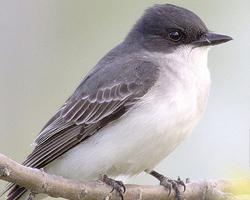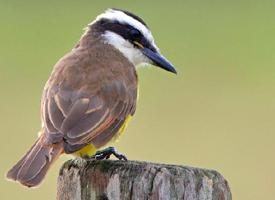
Greutăți și măsuri
| Lungime | de la 12 la 16 cm |
|---|
Descrierea animalului
The Eastern Phoebe (Sayornis phoebe) is a small passerine bird belonging to the Tyrannidae family, which is notable for its widespread presence across eastern North America. This bird species is distinguished by its modest appearance, endearing behavior, and remarkable adaptability to various habitats, making it a familiar sight to many bird enthusiasts and naturalists. With its subtle charm and ecological significance, the Eastern Phoebe plays a vital role in the biodiversity of its range.Physical Characteristics:
The Eastern Phoebe typically measures about 5.5 to 6.7 inches (14 to 17 cm) in length, with a wingspan ranging from 10.5 to 11.0 inches (26.5 to 28 cm). It has a relatively lightweight body, weighing between 0.6 to 0.7 ounces (16 to 21 grams). The bird's plumage is primarily dull grayish-brown on the upper parts, with a slightly darker head and a faint olive hue on the wings and tail. The underparts are off-white to pale yellow, with the lower belly and undertail coverts showing a more pronounced yellowish tint. Its bill is black, short, and thin, adapted for catching insects in flight. The Eastern Phoebe has a lack of vibrant colors, which helps it blend into its surroundings, making it less conspicuous to predators.
Behavior and Ecology:
One of the most distinctive behaviors of the Eastern Phoebe is its frequent tail-wagging, a characteristic movement where the bird flicks its tail up and down when perched. This species is primarily insectivorous, feeding on a wide variety of flying insects, including flies, beetles, and moths, which it often catches in mid-air in agile flights. During the colder months, when insects are scarce, it supplements its diet with small fruits and berries.
Eastern Phoebes are solitary and territorial birds, especially during the breeding season. They are among the first migratory songbirds to return to their breeding grounds in early spring. The species is known for its loyalty to nesting sites, often returning to the same location year after year to breed. Nests are typically built in sheltered locations, such as under bridges, inside barns, or under house eaves, using mud, moss, and grass, forming a cup-shaped structure.
Reproduction:
The breeding season for Eastern Phoebes starts in early spring, with females laying a clutch of 2 to 6 creamy-white eggs, which are incubated for about 16 days. The chicks are altricial, meaning they are born blind and featherless, completely dependent on their parents for food and protection. Both parents share the responsibility of feeding the chicks, which fledge about 16 days after hatching. Eastern Phoebes often raise two broods per year.
Conservation Status:
The Eastern Phoebe is considered to be of Least Concern by the International Union for Conservation of Nature (IUCN), owing to its wide range, large population, and the absence of significant declining trends. However, like many bird species, it faces threats from habitat loss, pollution, and climate change. Conservation efforts aimed at preserving natural habitats and promoting biodiversity are essential to ensure the continued survival of this species.
In conclusion, the Eastern Phoebe is a modest yet fascinating bird species whose presence enriches the ecosystems of eastern North America. Its adaptability, interesting behaviors, and ecological role make it a cherished subject of study and observation among birdwatchers and conservationists alike.
Animale similare
Fotografii noi cu animale
Top 10 animale
- Dolphin gull (Leucophaeus scoresbii)
- Diana monkey (Cercopithecus diana)
- Moustached guenon (Cercopithecus cephus)
- Stone loach (Barbatula barbatula)
- Greek tortoise (Testudo graeca)
- Galápagos tortoise (Geochelone nigra complex)
- Japanese macaque (Macaca fuscata)
- Russian tortoise (Testudo horsfieldii)
- Common flying dragon (Draco volans)
- Galápagos penguin (Spheniscus mendiculus)

